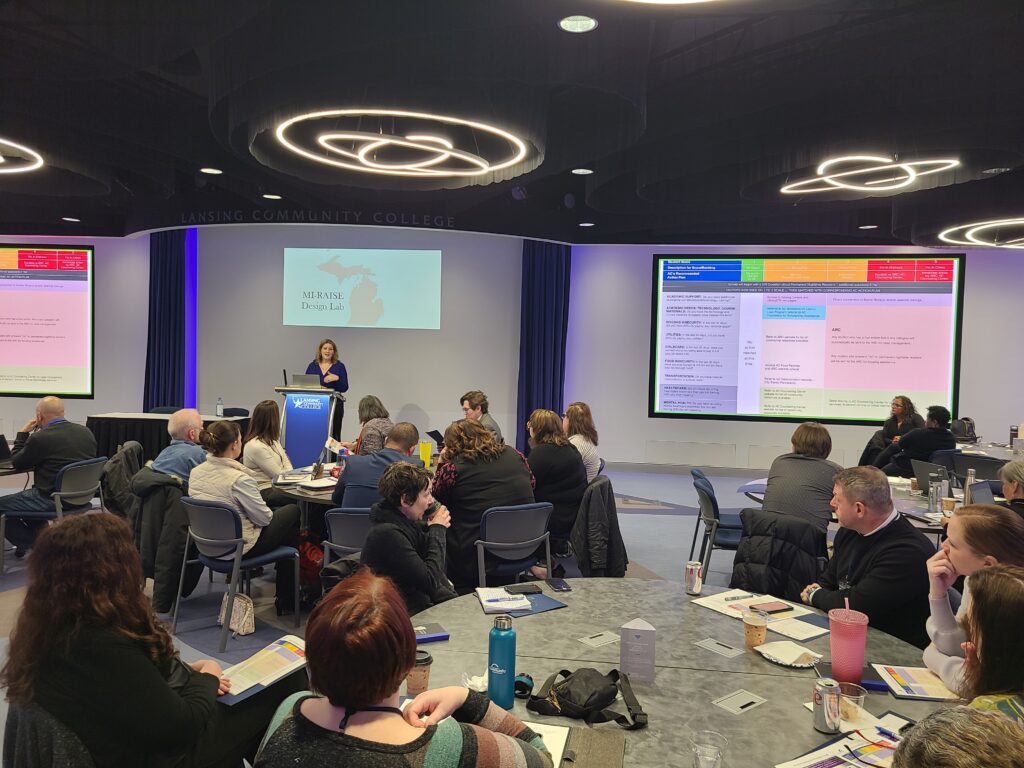West Michigan’s population is increasing in diversity across race and ethnic identities. Our region is expected to experience a 4% population growth (JPG) in the next 10 years gaining almost 36,000 Hispanic residents by 2033, which is more than double the amount of growth amongst white residents and nine times more than the growth amongst Black residents.
Since 2010, TalentFirst has played a significant role in illuminating racial and ethnic disparities (PDF) in education and the labor force. While we show evidence of progress when it comes to reducing disparities in labor force participation and unemployment rates, we have seen little progress and even greater disparity for some when it comes to per capita income and the share of adults with education beyond high school.
For our region to thrive and become a top 20 region in the nation, individuals and businesses must thrive together. West Michigan employers must attract, develop, and retain talent that is diverse, which requires employer-led strategies that include diversity, equity, and inclusion (DEI) criteria. This will result in greater economic opportunity and participation in the labor force across all races and ethnicities in our community.
As part of TalentFirst’s commitment to Workforce DEI, we regularly convene CEOs and organizational talent and diversity leaders through our Workforce DEI Working Group. This group champions our four strategies that help West Michigan employers make measurable progress for their business. The group engages in discussion, learning, and sharing of best practices surrounding workforce DEI during our working group meetings and, from time to time, more broadly with members of our CEO Council and HR Council.
Recently, the working group hosted a virtual education session with subject matter experts from Warner Norcross + Judd LLP leading the conversation about the Workforce Implications from the Supreme Court’s Affirmative Action Ruling. Some may think this decision has nothing to do with employers since it focused on higher education institutions. However, the subsequent actions of attorneys general and lawsuits targeting large companies and law firms across the nation indicate that the ruling is having a ripple effect beyond higher education admissions.
Legal Context
The session began with our hosts educating us on the legal context and practical workforce implications of the affirmative action decision. This recent ruling by the Supreme Court of the United States (SCOTUS) stems from two cases against higher education institutions’ admissions processes — one against Harvard and the other against University of North Carolina (UNC). The plaintiffs argued that the consideration of race violated Title VI of the Civil Rights Act and the Equal Protection Clause of the 14th Amendment. While reviewing these cases, SCOTUS employed strict scrutiny — a form of judicial review courts use to determine the constitutionality of certain laws.
Informed by previous cases against higher education institutions in California (1978) and Michigan (2003), the court found flaws in the admissions processes at Harvard and UNC leading to the decision to dismantle affirmative action in college admissions. These flaws include:
- Failure to further compelling interest due to the difficulty for courts to measure the educational benefits identified by the schools and the lack of clarity surrounding how avoiding underrepresentation of minority groups furthers such educational benefits.
- Use of stereotyping in that the admissions practices assume that a BIPOC candidate can offer something a White candidate cannot.
- Use of non-minority race as negative in that fewer White and Asian candidates have been admitted because college admissions is a zero-sum game.
- No end date to the affirmative action practices was established.
Included in the decision is a clause written by Chief Justice John G. Roberts, Jr. that “Nothing in this opinion should be construed as prohibiting universities from considering an applicant’s discussion of how race affected his or her life, be it through discrimination, inspiration or otherwise.” Still, he cautions against using essay questions to indirectly factor race into admissions decisions.
For the State of Michigan, this is not new. In 2006, Proposition 2 passed into Michigan Constitutional law prohibiting the consideration of race, color, sex, or religion in college admissions processes, jobs, and other publicly funded institutions. Universities across Michigan pivoted to being more inclusive and expansive in their recruiting efforts by raising awareness and accessibility to post-secondary education through recruiting students eligible for PELL grants and across various areas of the state where there is greater ethnic diversity.
While this SCOTUS ruling on June 29, 2023, does not directly apply to employers, there are practical implications to consider.
- We are likely to see an uptick in reverse discrimination lawsuits alleging that DEI measures are evidence of discrimination against White or male applicants and employees.
- Already we are seeing state-level legislation being introduced to challenge, weaken, or eliminate DEI initiatives.
- Any decline in diversity amongst college graduates locally and nationally likely leads to a less diverse applicant pool, especially for skilled positions.
Action Steps for Employers
What can employers do to continue attracting, developing, and retaining people of diverse backgrounds in West Michigan? Evaluating and rethinking your recruiting, hiring, and retention strategies is a great place to start.
- Evaluate your employee referral programs. Referral programs often diminish opportunities to diversify your workforce because people are connected to people with similar values and life experiences. Is your referral program helping or hindering your business?
- Broaden your talent pipelines. Who do you have recruiting relationships with? Which colleges or universities (in state and out of state) could you be recruiting from that you have yet to tap into? Are you partnering with community organizations supporting underestimated or underrepresented populations? Do you have a presence within K-12 schools giving students exposure to your business and industry for the future?
- Calibrate your candidate evaluation. Consider doing first-round screenings blind (i.e., removing identifying characteristics from an application). Use consistent, behavioral-based interview questions for each candidate to glean information on transferable skills from each person’s experience.
- Rethink requirements and dealbreakers for a job. Is a specific degree or any degree truly required? Could there be other ways for a candidate to gain similar knowledge or transferable skills? Does a person’s criminal background truly impact their ability to perform the job?
- Assess retention strategies. Are your employee events, benefits, and development opportunities inclusive of individuals from all backgrounds and walks of life? For example, mentoring is a strong retention strategy, but everyone does not need the same type of mentorship. They need the right type of mentorship for them as an individual.
- Revise your definition of DEI-related attributes. A diverse, equitable, and inclusive workplace is about more than hiring traditionally underrepresented groups. While you cannot ask candidates about protected areas like race, ethnicity, sex, and religion, you can inquire about how they have proactively supported their schools’ or past employers’ equity and inclusion efforts.
Resources for You
TalentFirst curates resources, tools, and events to help employers implement strategies and best practices within your organization. Members of our HR Council, CEO Council, education institutions, and community-based organizations partner with us in creating these resources and informing the strategies by humanizing our data and research.
This month we published the third edition of the popular Talent Solutions Playbook which will be distributed throughout the Talent Solutions Series this Fall. The series is a platform for West Michigan employers and HR professionals to connect with peers and local and national thought leaders. This year we have added more direct engagement and hands-on activities focused on deployable solutions for you to attract, retain and develop diverse talent through:
- Expand Your Talent Pipeline – Sept. 13th
- Strengthen Your Employer Brand – Oct. 11th
- Enhance Onboarding & Career Pathways – Nov. 8th
Specific to Workforce DEI, TalentFirst developed PIVOT, an employer toolkit. The toolkit exists to support CEOs and their leadership teams championing the efforts to create a West Michigan community that is welcoming — a place where anyone can succeed and thrive. It contains valuable resources, best practices, and examples from employers across the region, including TalentFirst’s DEI Guidebook, Five Essential Competencies of Effective Diversity, Equity & Inclusion Leaders (PDF) by Whitney White in collaboration with members of the Workforce DEI Working Group.


